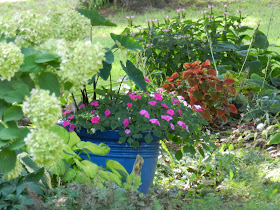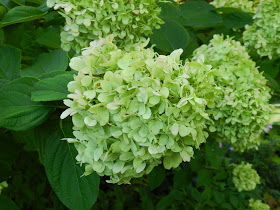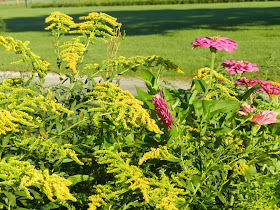 |
| The asters and goldenrod apparently got the notice that it is autumn. |
While I'm sure I learned many new things this past season, my mind is drawing a blank. The problem is that by mid-July, I lost all my motivation for serious gardening. By that time I was tired of constantly pulling weeds: the consistent rain this season was a blessing, but at the same time it meant the weeds flourished, too. After an hour or two of weeding or trimming or picking green beans, the sweat was rolling into my eyes, and I gave up. I guess that means I've learned that I am a fair-weather gardener--if it's hot and buggy, I'm staying indoors.
Instead of doing much actual garden work for the past two months, I have spent a lot of time on my front porch noting all that has to be done and making plans for those perfect "somedays" when the temps are are in the 70's, the bugs have stopped biting, and I'm full of energy.
From my shady perch on the porch swing, I can easily see the coneflowers when they're in full bloom and get a partial view of the lily bed and even the arbor bed beyond that.
If I stand up and crane my neck a little, I can even see parts of the shade garden as well. The best part about this viewing at a distance is that I don't really see the weeds or the deadheading that needs to be done, and I can just relax and procrastinate to my heart's content.
With several planters on or near the front porch, I have much to enjoy close-up as well, such as this hibiscus. Fortunately, the only upkeep these planters require is frequent watering, which I do pretty faithfully since it doesn't mean working up a sweat.
Besides looking at what is blooming, my place on the porch gives me a great vantage point for watching all the visitors to my garden. When the coneflowers bloom, the nearby sidewalk garden is alive with butterflies. And with only a few short steps, I can get up close to observe and photograph them.
Once the coneflowers have faded, the butterflies are replaced by the goldfinches who are constantly feeding on their seedheads. From the porch's front step I can zoom out with the camera to get a photo if I'm lucky.
The porch gives me a great vantage point, too, for observing all kinds of bird activity throughout the seasons besides the goldfinches, from hawks swooping through the air looking for prey to cardinals feasting on the tiny crabapples. But my favorite bird activity is only a few feet away as the hummingbirds visit the feeder just beyond the swing.
 |
| Tiny syrphid flies are just one of the many pollinating insects to be found in the garden. |
Looking through all these photos, I am reminded that I have learned another lesson this summer--I have learned much more about pollinators. I took a few hours' training to become a "Pollinator Pocket" presenter, a program developed by our local Extension Office. I learned so much about different insects and other pollinators and their life cycles.
I also learned more about the needs of these different pollinators, including plants that will help to feed them. I already knew that asters and other late-blooming plants provide a valuable food source in the fall. But a local beekeeper at the workshop reminded everyone that bees need food in the early spring as well, and he encouraged us all to plant more crocuses because they are one of the few sources of food very early in the spring. You can be sure when I placed my bulb orders this past week that I ordered plenty of crocuses!
 |
| Not sure what type of bumble this big guy is. |
Earlier in the summer I also attended a talk by Dr. Sydney Cameron, an entomologist specializing in bumblebees, on the rare Rusty-patched Bumblebee Bombus affinis. We watched a short but fascinating documentary on this bee called "A Ghost in the Making," which you can find here on YouTube. The rusty-patched bumblebee was once very common in parts of the U.S., but for reasons unknown its numbers have dwindled, and it is now being considered as an endangered species.
This talk inspired me to look more closely at the bumblebees in my own garden, and while I can't identify them by type, I know that my visitors are the much more common species normally seen throughout this area. Still, I am searching for that elusive rusty-patched bumblebee!
 |
| Linda of Each Little World and Lisa of Greenbow enjoy chatting with Susan. |
We didn't find any rusty-patched bumblebees on this day, but we did see many other species, and Susan mentioned that one of their favorite plants this time of year is the native thistle.
Looking back, I realize that maybe I did learn more this summer than I realized. I know I'm going to be more conscious of pollinators and do what I can to increase their numbers in my garden. And while I've enjoyed the past two months on the porch, this morning is much cooler and pleasant, so it's time to get off that swing and get to work!
For more reflections on lessons learned in the garden this past season, be sure to stop by Beth's at Plant Postings.


































